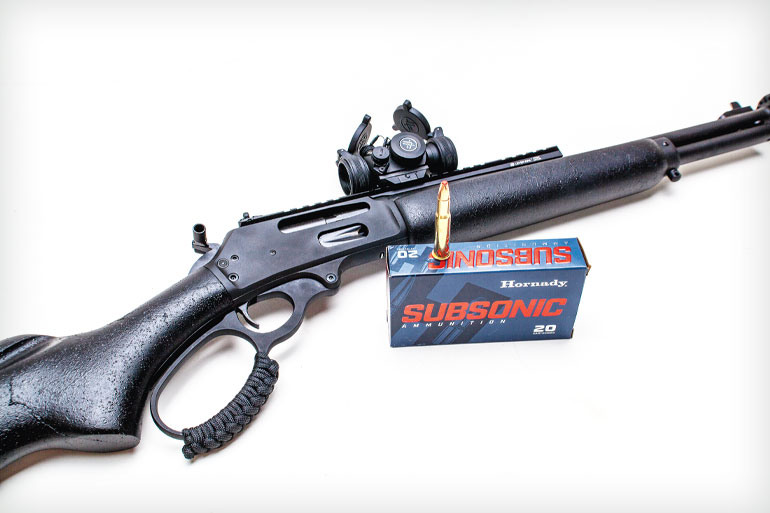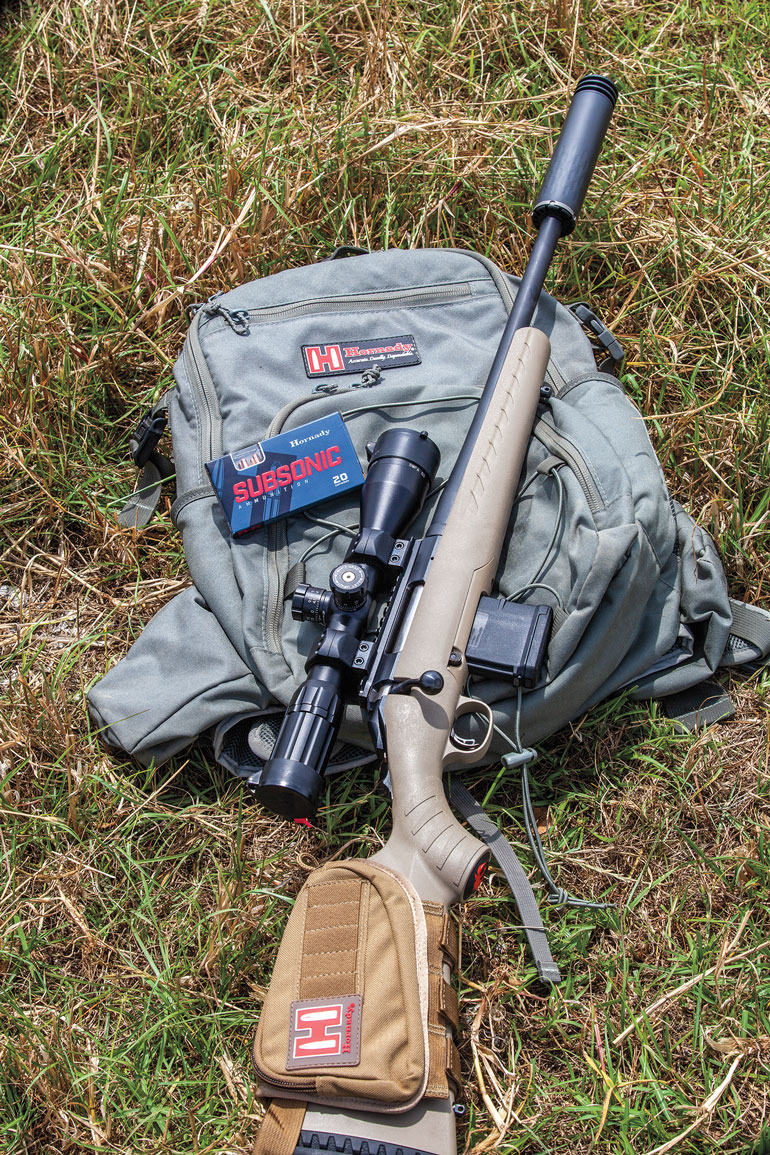
Twenty years ago, suppressors were a rarity in the civilian shooting world. The legal challenge of owning a suppressor made them unattractive to most shooters, and few if any major manufacturers produced them. Today, suppressors seem to be everywhere. Competitive rifle shooters, defense-minded individuals and hunters can be seen with these sound-reduction devices attached to their firearms.
As great as they are, suppressors have a problem. They can control the muzzle blast and report of a rifle cartridge, but they can do nothing to mitigate the crack associated with a bullet passing through the sound barrier. Technology can’t trump physics.
The solution is to slow down the bullet below the supersonic threshold. That is easier said than done, especially when you don’t want to sacrifice terminal performance. Ammunition manufacturers have had a tough time solving this, but Hornady, with its Subsonic rifle line, threads the needle.
Most of the time I’m hunting or shooting with a suppressor, I am not interested in making the rifle as quiet as possible. For range or general hunting use, it is sufficient that the suppressor reduces the recoil and muzzle blast as well as brings the report down to hearing-safe levels. For these needs, subsonic ammunition is not necessary.

There are times, though, when I want things to be as quiet as possible. For me, this usually applies when I am hunting feral hogs that are destroying a farmer’s field. In such circumstances, subsonic ammunition can be a game-changer.
As we have seen suppressor use skyrocket in this country among hunters and shooters, specialized cartridges and loads have entered the market. The most popular cartridge that was purpose-built for suppressor use is undoubtedly the .300 BLK.
Though Advanced Armament Corporation gets credit for standardizing the cartridge, much of the innovation happened years earlier. J.D. Jones of SSK Industries developed the .300 Whisper cartridge specifically to perform in semiautomatic, bolt-action and single-shot rifles at subsonic velocities.
Though there are slight dimensional differences between the two cartridges, the .300 Whisper and the .300 BLK are both based on the .221 Fireball case, necked-up to 0.308 inch. By going to a far heavier bullet than the case was designed for, SSK and AAC were able to achieve subsonic velocities while still maintaining a safe and reliable powder capacity.
One of the most attractive elements of the .300 BLK is its compatibility with standard AR-15s and magazines. Since ARs have become the most popular rifles in America, this is not a small thing. If an AR owner wants to dip a toe into the subsonic water, buying a .300 BLK upper is all it takes. For deer-size game at reasonable ranges, this cartridge offers plenty of power in a handy package.
The .300 BLK can be very effective when subsonic use is preferred, but it is by no means the only option. When Hornady launched its Subsonic line of rifle ammunition in 2018, it began with the .300 BLK. This year the company added several more options.
For 2020, Hornady’s Subsonic rifle selection comprises four loads: the 190-grain .300 BLK, 175-grain .30-30 Win., 395-grain .450 Bushmaster and 410-grain .45-70 Gov’t. I sampled the .300 BLK and .30-30 Win. loads using two popular and commonly available rifles: a Ruger American Ranch Rifle and a Marlin Dark Series 336.
The Ruger American line has built a reputation for performance, often outshooting guns that retail at far higher prices. My .300 BLK sample was one of the newer Ranch models, with a five-round detachable box magazine, Picatinny rail and a 16.12-inch threaded barrel. I mounted a 3-9x42mm scope from SWFA in Burris Signature rings. With a suppressor attached, the Ranch Rifle measured 42 inches overall and weighed 8.9 pounds.
The .30-30 test rifle was a modern twist on an age-old design: the Marlin Model 336 Dark Series. This rifle is a tricked-out Marlin lever gun with a threaded barrel, black painted stock, XS optic rail and ghost-ring sights.
If you are in the market for a suppressor-ready lever-action .30-30, this rifle is about the only lever-action game in town. Yes, the Mossberg’s 464 SPX Flex is threaded for its standard A2 flash hider, but you would need to buy an adapter because that thread pattern is 1/2×28 while almost all centerfire suppressors are 5/28×24. You can find adapters at retailers like SilencerShop.com.
The optic rail on the 336 Dark Series provides a great deal of mounting real estate, but the rifle’s stock geometry is such that a scope must be mounted low for a proper cheek weld. After experimenting with various options, I chose Leupold’s VX-5HD 1-5×24 for its useful magnification range and an objective lens that allowed me to mount it down low. This scope is equipped with a CDS elevation dial, which is particularly useful given the rainbow trajectory of subsonic rifle loads.
Both rifles came suppressor-ready right out of the box with 5/8×24 threads at the muzzle. I mounted my SilencerCo Omega 300 suppressor and traded it between the two rifles for the testing.
With the suppressor in place, recoil was almost nonexistent with both rifles. The “thump” of the bullets impacting the dirt backstop was louder than the shot. The combination of soft recoil and slow velocities allowed me to consistently see my rounds impact on target at 100 yards. This low recoil and mild report demonstrates just how valuable suppressors can be for training new shooters and hunters, particularly younger individuals.
In case you’re wondering, subsonic rifle ammunition isn’t noticeably quieter than standard velocity loads unless a suppressor is used. If you fire it without a suppressor in place, it’s going to damage your hearing just like standard ammo would.
I grew up in and still hunt frequently in Florida where feral hogs have been present since the Spanish brought them over in 1540. They can be extremely destructive to habitat, and we pursue them aggressively.
When the .300 BLK came onto the scene, many of my friends and I began using it with suppressed AR-15s, hoping for the chance of taking out several members of a sounder without alarming the group. We found the sound reduction to be excellent but the terminal performance lacking.
Early attempts at subsonic ammunition often used off-the-shelf .30 caliber bullets that were designed to expand at the far faster velocities of the .308 Win. or .30-06. These bullets would pencil through the hogs, causing minimal trauma. Ethically, this was not acceptable.
This is the exact problem that Hornady’s ballisticians sought to solve when they developed this product. When they set their sights on developing their Subsonic rifle ammunition, they started from scratch in terms of bullets. The result of their research and testing was the Subsonic-eXpanding or Sub-X bullet.

Sub-X bullets use a traditional lead core and a thin, grooved gilding metal jacket. There is a generous hollowpoint fitted with a polymer Flex Tip insert that aids expansion and allows the bullet to be safely compatible with the tubular magazines found in most lever guns.
From top to bottom, this bullet is engineered to expand. The exact definition of subsonic depends on some environmental factors, but it is generally just below 1,200 fps. This combination of features on the Sub-X allows it to reliably expand at subsonic velocities, even down to 900 fps. With an impact velocity of 1,020 fps, Hornady has achieved 16 to 18 inches of penetration on ballistic gelatin with 90 percent weight retention.
I chronographed both loads on a reasonably warm day, with temperatures hovering around 85 degrees. The .300 BLK load had an average velocity of 1,087 fps, which meant it was consistently subsonic. At this speed, the Sub-X bullets would expand out to about 400 yards. With 200-plus inches of drop at that range, I don’t see myself taking such a shot on game. Accuracy was good, with the best group of the day measuring at under a half-inch and an average of three three-shot groups right at an inch.
The .30-30 load actually moved quite a bit faster, with the average velocity from the Marlin 336 being 1,198 fps from the 16.25-inch barrel. When I shot on hotter days, some of the .30-30 rounds actually broke the sound barrier, making for a noticeably louder report downrange. When temperatures were in the 70s or lower, this was a non-issue. This illustrates just how difficult it is to construct ammunition that will perform consistently in a wide variety of firearms under wildly different conditions.
I tried to connect with a wild boar while I had the guns in my possession, but fortune didn’t smile on me. However, I know Hornady’s Neal Emery and several others took pronghorns with the Subsonic in .30-30 and .300 BLK—each with just one shot. Emery’s buck was shot at 87 yards, and he found his Sub-X bullet fully expanded against the off-side hide, and it had mushroomed just as advertised.
That kind of performance represents a stark contrast to what I’ve seen from other manufacturers’ efforts at subsonic ammunition. My son will hunt deer for the first time this fall, and given the performance I’ve seen from the Hornady Subsonic rifle ammunition, I won’t hesitate to let him use it.
Barring some legislative catastrophe, suppressors are here to stay. For good reason, too. Size and cost aside, why wouldn’t you want something that reduces recoil and muzzle blast? And to maximize the utility of suppressors, subsonic ammunition is a key element in the equation.
Hornady has been a leader in its field for decades and is once again driving innovation. The company’s Subsonic rifle ammunition allows for a minimum sound signature without a subsequent loss in lethality.
Hornady Subsonic Rifle Ammo Accuracy Results












































